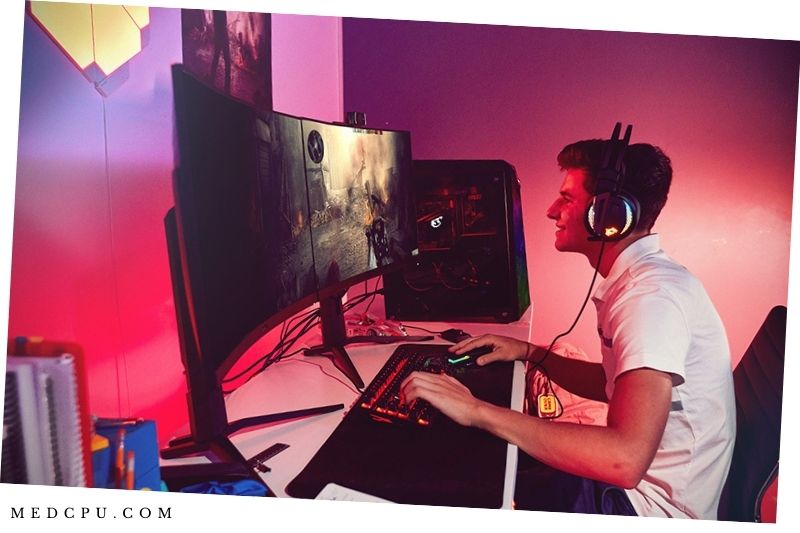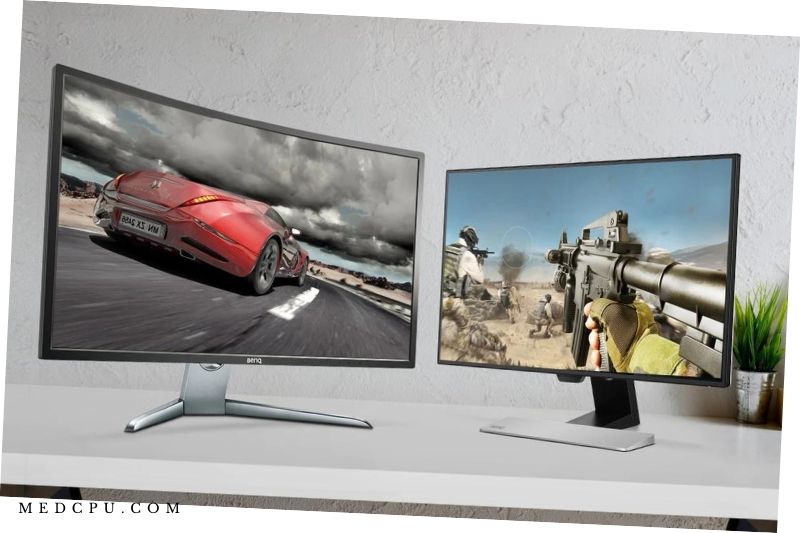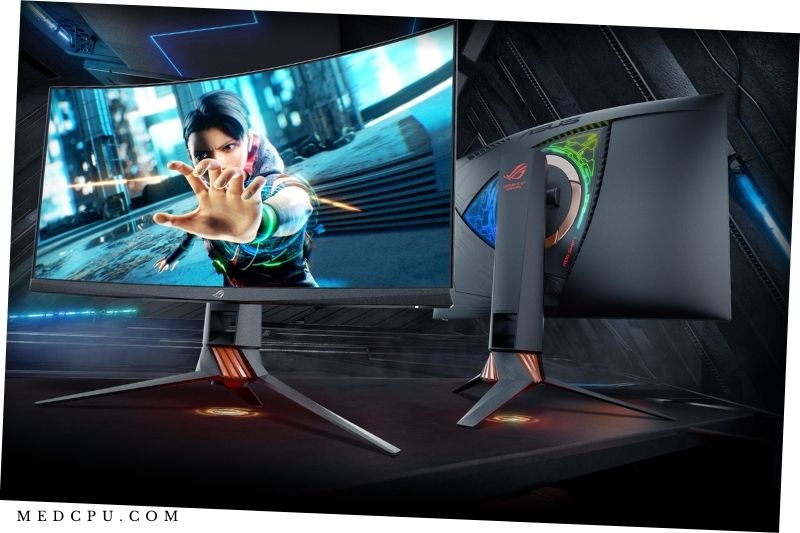There are many types of monitors on the market today, most of which are flat screens. Flat screens are good for most people because they are cheap, usually have a variety of screen sizes, and are more easily seen.
How about curved monitors? Are curved monitors good for gaming? Some people prefer curvier screens because they think they can improve their gaming experience. Read on MedCPU’s guide below to find out.
What is a Curved Monitor?
Since 2014, when the first curved monitors hit the market, curved monitors have existed for a while. However, they have only recently gained popularity as their prices continue to drop. There is no physical difference between a flat and curved monitor, except for the curvature.
These monitors are marked with an R or radius. This radius is measured in millimeters. Today’s curved monitors will have one of three common R measurements: 1800R 3000R or 4000R. The curve will be larger if the number is lower than the others. This is similar to how aperture works in an SLR camera.

A lower number means that the aperture will be wider. These are not all measurements available for curved monitors. You’ll also find radius measurements in the range of these three numbers.
Although curved monitors can be as small as 24-inches in size, it is better to have a curved gaming monitor with a larger screen size (32-inches or more). The intended effect of a curved screen will diminish the smaller the monitor gets.
Pros of a curved monitor
Using a curved monitor has many advantages. There are many things you can learn about curved monitors from almost every website that sells them. These include:
- Ultrawide monitors offer a wider viewing angle of 30%.
- Virtual reality games that use a curved screen have a natural feel.
- Simulator games are great for both single players and single viewers.
- More consistent color saturation from different viewing angles.
- Multitasking helps you to be more productive.
- Cool and pronounced
- The angle of the whole screen has the main benefit for me. You feel like you’re playing the game because of the curvature.
Games that emphasize exploration, detail, and immersion will benefit significantly from the amount of real estate available to them.
Read also our comparison between 24 Vs 27 Monitor in 2024, Click here
Cons of a Curved Monitor
- It works best when you only have one monitor.
- For effect to be effective, you will need a 32-inch or larger screen.
- The display must be viewed from the middle.
- Expensive.
- This product can cause glare and image distortions.
- Reflections in the center will be amplified
- Software/platform support is required for games
Curved monitors and gaming have one major flaw. You must sit in the middle of the screen for optimal viewing. Curved monitors are designed to provide a unique viewing experience for one viewer.
More than one person or viewer cannot use a curved screen on a single screen. If you enjoy playing on the same screen as your friends, this is something to think about.
You will feel as though you are driving a custom-built computer. This reminds me of Gordon Murray’s McLaren F1 design philosophy.
Flat vs Curved Monitors: What are the differences?

While one monitor is better than the next, some key factors can affect how you experience gaming with a flat monitor or curved gaming monitor. Let’s take a closer look at the differences between a curved screen vs flat screen.
Size and weight
Curved gaming monitors can be wider than flat-screen monitors. This is because they are more immersive. The screen must be large enough to cover the player’s peripheral vision. The curved edges make it easier than a flat monitor to see all of the screens simultaneously while you are close to it.
Flat-screen monitors can be from 23 to 27 inches in width, though you will still find many that are 32 to 43 inches or larger. The Acer Nitro XV272U monitor is a decent size for a flat display. It measures 27 inches. Curved monitors on the other side, however, start at 27 inches and extend from there. For instance, Samsung’s CHG9 Series ultrawide is staggering at 49 inches wide, which is more than four feet.
The Samsung display is 33.1 pounds heavier due to its increased width. The LG 34WN80CB-B is a standard ultrawide monitor measuring 34 inches in width, weighing 23.3 pounds. The 27-inch Acer, though smaller in size, is 10.82 pounds lighter.
If you intend to mount an ultrawide display, you will need a stronger wall mount than you would for smaller displays. You will need to mount the monitor if you don’t intend to. Make sure to look at the quality of your stands before you decide whether a flat or curved monitor is right for you. A wobbly stand is not something you want with an ultrawide monitor.
Color quality
Each monitor can display different amounts and qualities of colors. Many gaming monitors now support HDR. This allows for high-quality luminosity in bright whites and dark browns.
A curved gaming monitor can offer better color consistency, as every pixel is ideally angled towards you. Flat screens can cause colors to appear slightly different depending on how far away they are from you and what angle you view them from.
Hardware
The number of pixels on the monitor will increase with increasing width. A graphics card capable of handling the extra output is required to run ultrawide games at high frame rates. Any of the Nvidia 3000 series graphics cards should handle the task if you can find one.
Refresh Rate
Whether you choose a flat or curved monitor, the refresh rates of these monitors vary greatly. They range from 60Hz for budget monitors to 144Hz and 240Hz for professional gamers. Due to the larger size of curved monitors (at least for those who want the best experience), you will likely pay more for a curved monitor with a higher refresh rate than you would for one with a flat-screen.
Your mileage will vary depending on the games you play and the purpose of your monitor. While flat-screen monitors can be used for many tasks such as video editing, digital art, and other tasks, curved monitors offer more power for those games that use the extra pixels. Ultrawide displays can be great for both work and play.
However, each buyer must decide if they require the extra width. Also, consider the additional weight and real estate. An ultrawide monitor is an excellent choice if you are serious about maximizing your visuals for personal enjoyment and competitive advantage. However, a high-quality curved screen will cost you more than a flat monitor.
Read also: Lcd Vs Led Monitor Gaming 2022: Which One to Choose?
Things You Will Need To Adjust
There is always a catch. This is especially true for curved monitors that seem too good to be true. The disadvantages of owning a curved monitor are negligible and can be overcome easily.
Wall Mounting
Curved monitors pose some difficulties when mounting to walls due to their curved shape. Curved monitors require special mounting and positioning in contrast to their flat counterparts.
Curved screens, in general, prevent them from being too close to the wall. They don’t solve the problem of curved screens jutting out. However, tilt brackets, and arm mounts that can adjust are great options to overcome this obstacle.
Glare
Curved monitors are susceptible to glare from sunlight or artificial light sources. This is due to the geometry of curved screens. Curved screens emit light at many angles instead of flat monitors, which have a uniform angle.
It might seem easy to keep light sources away from a certain angle to minimize glare, but keeping them from multiple angles can be challenging. This problem can be solved by removing your monitor from as many light sources as possible.
You can also use your monitor without any lights on, but that could pose a problem for your eyes’ health.
It’s better to be bigger.
Monitors are available in many sizes and shapes. However, curved monitors recently made their way into the ultrawide market. Ultrawide curved monitors have a unique aspect ratio of 21:9, rather than the 16:9 aspect ratio most people are used to.
They offer 33% more screen space than 16:9 monitors. This harmonious combination of ultrawide and curvature displays creates a beautiful display. The extra horizontal screen space further enhances the advantages of curved monitors, as we have already mentioned.
Ultrawide monitors are also great for those who use multiple monitors to do their work or play games. Some video games have a 21/9 aspect ratio, which means that you can enjoy all the benefits of a curved monitor as well as a wider field of view.
FAQs about Curved Gaming Monitor

Do pro gamers use curved monitors?
Curved monitors are not a new thing to the gaming industry, but they have been getting a lot of attention recently. The panels of the monitor curve inward from top to bottom, which is said to provide a more immersive gaming experience. Curved monitors have been used by pro gamers for years, and the demand for these monitors in the gaming industry has only grown.
Unfortunately, these monitors can be quite expensive. If you are a serious gamer, then a curved monitor might be a better fit for you.
Are curved monitors bad for FPS games?
The curved monitors are good for those who want more immersion and those who want less motion blur and better viewing angles. However, there is a downside to this type of monitor. FPS games do not work as well on a curved monitor. You may see your crosshair drift off the screen and be difficult to locate, which will make it more difficult to play.
Is curved better than a flat-screen monitor?
There are many advantages of a curved monitor over a flat-screen. The first major one is the increased field of view, which is a great feature for gamers. With a curved monitor, you can see a larger area of the screen at any given time. This is a benefit over a flat-screen monitor where only a portion of the screen can be seen at a time. A curved monitor is better than a flat-screen monitor.
Do curved monitors reduce eye strain?
A recent study by the University of Washington in Seattle found that curved monitors reduce eye strain. Another study in the US by the National Eye Institute showed that adults who use devices for more than two hours each day are at risk of eye-related problems.
Can you work on a curved monitor?
Curved displays are designed to improve the viewing experience by giving your eyes less distance to travel to the edge of the screen. This is good for gaming but can be tiring for work.
Because the distance from your eyes to the screen is reduced, there is less room for your eyes to move before they start feeling tired. Curved screens should be avoided if you need to look at a monitor for more than two hours a day.
According to the University of Texas at Austin, office workers should not look at a monitor for more than 30 minutes at a time. If you work on a curved display for an extended period of time, your eyes may get tired easily.
What should I look for in a design monitor?
A design monitor can differ in size, resolution, brightness, and color accuracy. The user should also look for a monitor that has an input for their laptop or desktop. They should also compare the price of the different monitors they are considering.
What does the R-Value mean in the context of Curved Monitors?
The radius that a curve would produce if it were a complete circle is the measure of a curved display. The curvature radius is indicated by the value R when measuring curved monitors. A 4,000R curved monitor would create a circle of 4m or 13.12ft radius. The curve of the monitor will be more curved the smaller the value of R.
R-value is the radius the curved-screen curve must reach to make a complete circle. If the screen surface was extended to make a circle, a 2,600R curved monitor would create a circle with a radius of 2,600 mm.
Conclusion
There’s no denying that a curved monitor looks better, is easier to use, and gives you a more realistic representation of the worlds in which you are playing. The design of a curved display helps make a smaller display look bigger, by drawing you closer to the screen and giving you a wider view. This way, gamers can enjoy a more immersive experience that takes advantage of their peripheral vision.
There are some issues that the curved monitors have. They may give players bad headaches, especially when playing long hours of FPS (first-person shooter) games.
This may happen because of the light reflection from the curved monitors. The gamer may have to adjust their monitor settings to turn off the light reflections from the backlight as well as from the screen.
I hope you find this guide helpful for you in choosing a new monitor. What do you think about curved monitors? What’s your experience with these? Let me know in the comments.
Video: Are Ultrawide Curved Monitors Worth It?

Eyal Ephrat serves as the co-founder and CEO of medCPU.com, where technology is making significant strides in the field of medicine. Through his experience in purchasing PC and laptop equipment and various other tech products, Eyal Ephrat contributes valuable insights to medCPU’s mission.
